Table of Contents
- Introduction
- Chapter 1: What Are the Different Types of Press Releases?
- Chapter 2: What Are the Elements and Format of a Press Release?
- Chapter 3: 9 Steps to Create an Effective Press Release
- Chapter 4: Distribute Your Press Release
- Engage Journalists More Effectively With Well-Written Press Releases From LeadsPanda
Introduction
Press releases have always been an effective way for businesses to disseminate information to the media and the public. However, the popularity of social media has raised the question of whether press releases are still a relevant form of communication in the digital age. This guide will explain why businesses should still use press releases, and highlight the scenarios in which a press release might be warranted.
What Is a Press Release?
A press release is a concise and formal written statement issued by a company, organization, or individual to the media, making an announcement or providing newsworthy information about a certain event or product. It aims to capture the attention of journalists and encourage them to cover the story or announcement in their publications or broadcasts.
Press releases typically follow a specific format, including a headline, dateline, introduction, body paragraphs with key details, quotes, and contact information for further inquiries.
By distributing press releases, organizations can generate publicity, enhance their brand image, and reach a wider audience.
Why Should You Create a Press Release?
While businesses have numerous ways to reach the general public today, journalists still view press releases as an important source of information. Members of the media are constantly under pressure to verify the authenticity and source of the information they report. Press releases allow them to receive information directly from businesses instead of relying on third-party sources or platforms that don’t have stringent fact-checking processes in place. Recent research showed that one-fifth of journalists ranked press releases as their most trustworthy source of information.
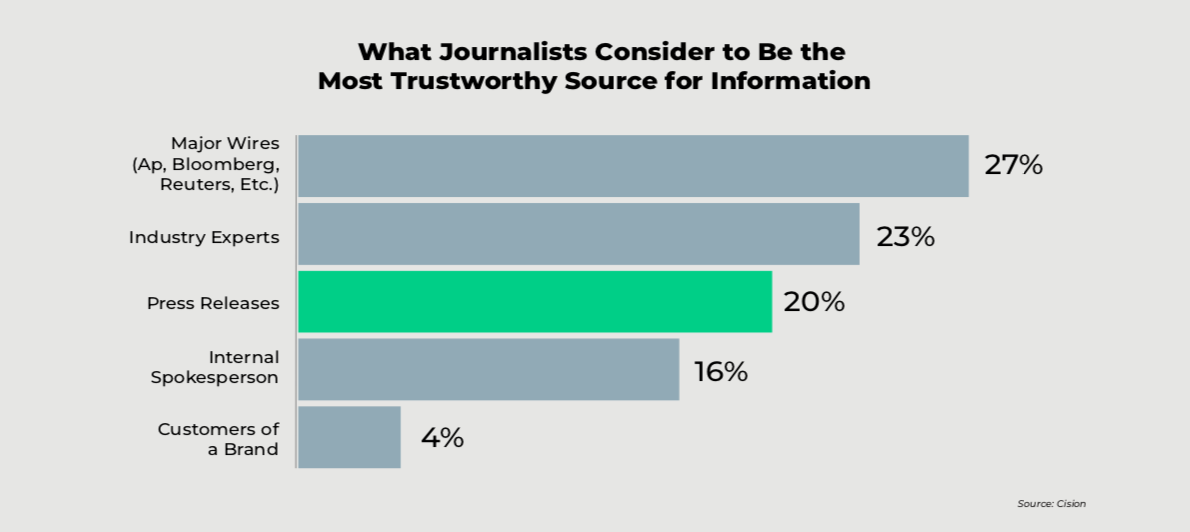
What Journalists Consider to Be the Most Trustworthy Source for Information
Press releases also help public relations teams build strong relationships with key journalists and media outlets that cover your industry. Journalists can easily use the media contacts displayed in press releases to ask questions and clarify information before publishing an article or social media post.
Additionally, a press release allows you to control how a piece of information is presented to the media and the public. Every announcement should closely align with your business’ overall communications strategy. This is especially important for announcements that are commercially, politically, or socially sensitive, such as new executive hires or notable acquisitions.
Chapter 1: What Are the Different Types of Press Releases?
Press releases can be used to disseminate many different types of information. Businesses have successfully used them in the following ways.
1. Product Launches and Updates
These press releases inform the public about an introduction or updates to a company’s products or services. They highlight the features, benefits, and market impact of the new offering.

2. Mergers and Acquisitions
Press releases about mergers and acquisitions provide information about significant business deals involving the company. They explain the rationale behind the merger or acquisition, its potential benefits, and the impact it may have on stakeholders.

3. Funding Announcements
These press releases inform the public about funding received by a company, whether through investments, venture capital, or other financial sources. They highlight the company’s growth potential and how the funding will be utilized to achieve business objectives.

4. Events
Press releases about events announce upcoming conferences, trade shows, seminars, webinars, or other corporate events hosted or sponsored by the company. They detail the event’s purpose, featured speakers, topics, and registration information.

5. Grand Openings
These press releases announce the opening of a new location, store, or facility. They provide details about the establishment, its features, products and services offered, and any special offers for the grand opening.

6. New Partnerships
Press releases about new partnerships highlight collaborations between companies to leverage each other’s strengths, expand market reach, or develop joint products or services. They describe the partnership’s goals, benefits, and the potential impact on customers or the industry.

7. Rebranding
Press releases about rebranding communicate significant changes to a company’s brand identity, such as new logos, slogans, or visual elements. They explain the reasons for the rebranding and how it aligns with the company’s vision, values, or business strategies.

8. Executive Promotions / New Hires
These press releases announce the appointment or promotion of key executives within the company. They highlight the individual’s qualifications, experience, and how their role contributes to the company’s growth and success.

9. Awards
Press releases about awards celebrate recognition received by the company or its employees for exceptional achievements, innovations, or contributions. They describe the award’s significance, the criteria for selection, and the impact it has on the company’s reputation.

10. New Research
These press releases announce new research findings, studies, or reports conducted by the company. They detail the research objective, methodology, key findings, and implications for the industry or customers.

11. Company Breaking News
Press releases about company breaking news cover unexpected or significant events that can impact stakeholders, such as a major lawsuit, regulatory changes, or crisis management strategies. They provide accurate and timely information to address concerns and maintain transparency.

12. Community Contribution and Initiatives
Press releases about community contributions and initiatives highlight a company’s efforts to give back to the community or support social causes. They showcase charitable partnerships, volunteer activities, or sustainability initiatives, emphasizing the company’s commitment to corporate social responsibility.

Chapter 2: What Are the Elements and Format of a Press Release?
Press releases usually follow a standard format and deviations from this format are generally discouraged. Journalists often have an extremely short window of time to evaluate the newsworthiness of press releases they receive, so a predictable organization of the information facilitates efficient comprehension.
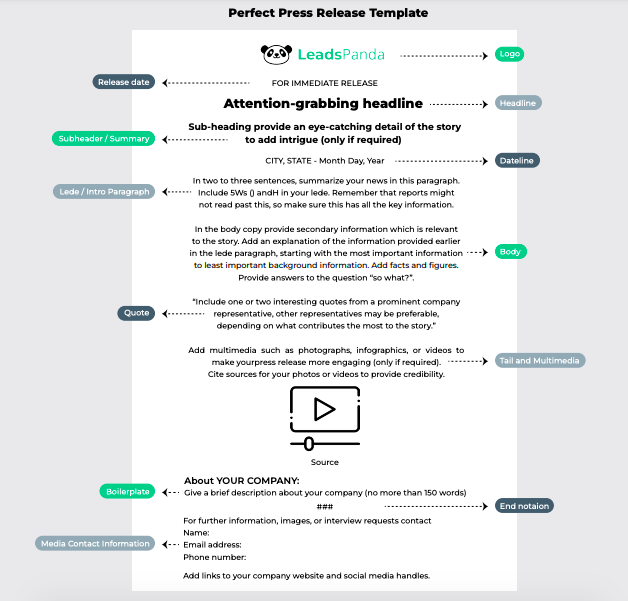
These are the elements that your press release should always have.
1. Headline
The headline of a press release is a concise, attention-grabbing statement that summarizes the main news or announcement being made. It should be captivating and provide a glimpse of the key information the press release contains.
2. Subheader / Summary
The subheader or summary is a brief sentence or two that elaborates on the headline and provides a bit more context or detail about the news being announced. It helps to further engage the reader and encourage them to continue reading the press release.
3. Dateline
The dateline is the first line of the press release and includes the date and location of the announcement. It establishes when and where the news is originating from and provides a reference point for journalists and readers.
4. Lede / Intro Paragraph
The lede is the opening paragraph of the press release. It should succinctly convey the most important information, starting with the location (city, state, or country if necessary) where the news is occurring. The lede paragraph aims to capture the reader’s attention and provide a clear and concise summary of the key points.
5. Body
The body of the press release contains the main content, providing more detailed information about the news or announcement. It should be organized into paragraphs or bullet points and cover the most important aspects of the story, such as details of the event, product features, or the impact of the news on stakeholders. The body of the press release should be informative, well structured, and support the main news being announced.
6. Quote
A quote is a direct statement from a representative of the company, such as the CEO or spokesperson, that adds a personal and human element to the press release. Quotes can be used to provide opinions, insights, or additional context, enhancing the credibility of the news and making it more relatable. These are often placed within the body of the press release or in a separate quote block.
7. Tail
The tail is an optional section that you can add to your press release. This section hosts any additional information you might want to share regarding the announcement. It is generally recommended that PR teams use this section to share complementary information that might have been announced in previous releases. If there is nothing noteworthy or relevant to be shared, this section can be omitted.
8. Company Info (Boilerplate)
The company info, or boilerplate, is a more detailed section that provides comprehensive information about the company, its history, key executives, products/services, and any unique selling points. It is usually included as a separate section at the end of the press release and provides journalists and readers with a broader understanding of the company beyond the immediate news being announced.
9. Media Contact Information
The media contact information includes the name, title, phone number, email address, and any other relevant contact details of the person who can be reached for additional information or interview requests. This section is essential for journalists who may require clarification or further details about the press release content.
Chapter 3: 9 Steps to Create an Effective Press Release
Once you understand how a press release should be formatted, it’s time to craft your release. Follow these steps to ensure your press release engages its audience in the way you want it to. If you have followed these steps, your press release should look like the diagram below.
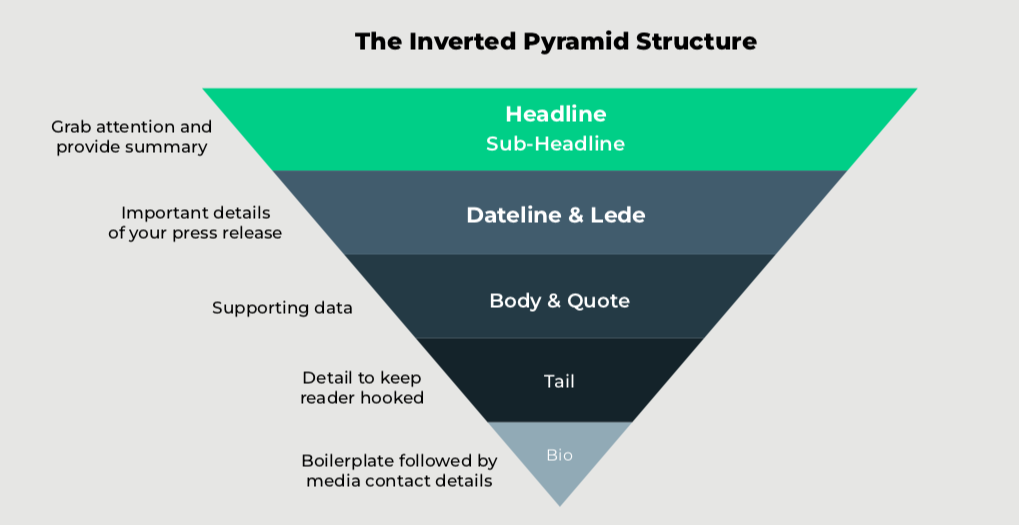
Step 1: Find a Newsworthy Angle for Your Target Audience
Journalists receive many press releases every day and most of them don’t get converted into news stories. An in-depth understanding of a journalist’s audience can help you pinpoint the most appropriate recipient for your press release.
Almost three-quarters of journalists say that the best thing a communications professional can do to make their job easier is to understand their audience. Reach out to journalists who share your audience and choose an angle for your press release that is tailored appropriately while being interesting and informative.
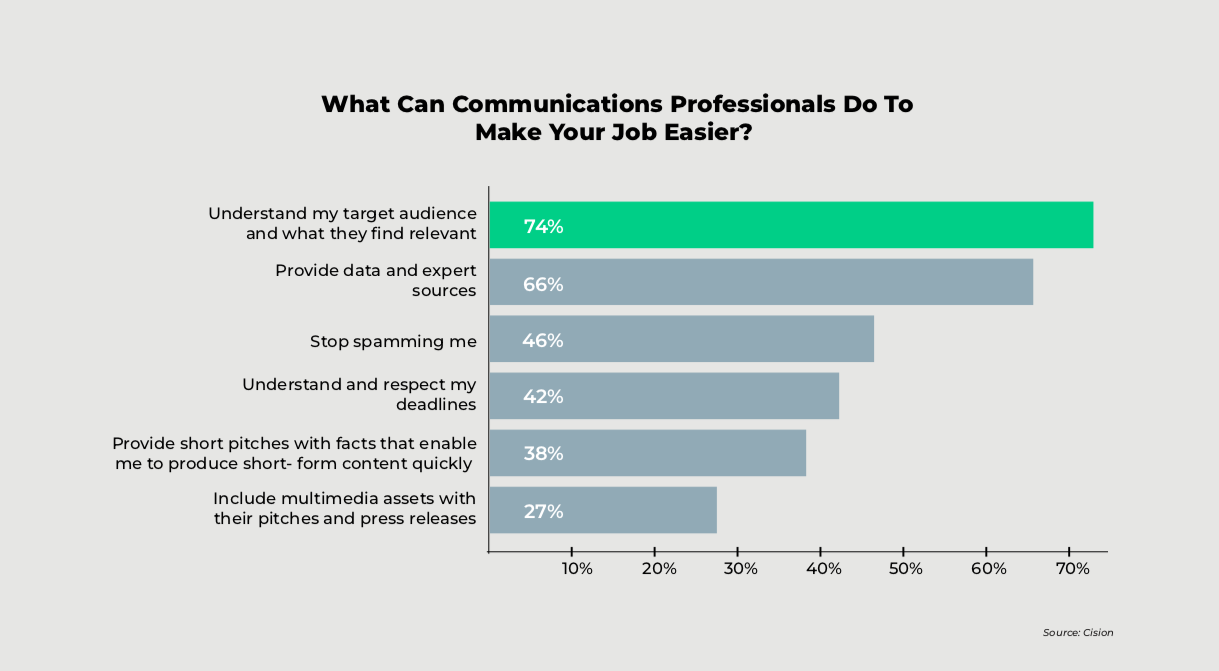
Step 2: Write a Compelling Headline
Your headline is extremely important in capturing your audience’s attention. It should be clear and concise. Your reader should understand the general idea of what your announcement is by reading the headline alone.
Step 3: Add a Contextual Sub-Headline or Summary
Some announcements can benefit from additional details. For example, companies that are using a press release to announce their attendance at an industry event might want to share their goals or reasons for being at the event. Sub-headings can be used to plug this information gap while still being separate from the main body of the press release.
Step 4: Add the Most Important Details
Every press release should cover the 5Ws and 1H — who, what, when, where, why, and how. The order and attention paid to each of these sections will differ depending on the specific announcement. Arrange these details based on what would be most relevant to your target audience.
Step 5: Add Supporting Data
Press releases are designed to help businesses share information with the media and the public. To do this effectively, companies need to understand the kinds of information that journalists and readers are looking for. In a recent survey, 68% of journalists said that they want to receive more data from businesses. Make sure to include supporting details in the body of your release to make it more compelling and newsworthy for journalists.

Step 6: Include Quotes From Key Executives or Partners
Quotes from relevant and involved executives and partners can lend an announcement authority and gravitas. This can help attract the interest of a journalist, since the view of the executive can be used as an alternative angle for the story.
Step 7: Add Details to Keep Readers Interested
If your press release is designed to be sent out to the general public along with media outlets, include information to keep readers engaged and interested. This can include recent updates about the business, key takeaways from the announcement, or additional resources that audiences could explore.
Step 8: Add Boilerplate and Media Contact
Businesses often have a boilerplate ready to go for press materials. This boilerplate includes an overview of the business, recent accolades, and key information about the company. This section should immediately be followed by contact details that can be used by a journalist who requires additional information or clarification.
Step 9: Edit
Once your release has been sent out, revising it can be extremely difficult. This is why PR professionals should always edit and proofread press releases before they are finalized to make sure that everything in the release is factually correct and in line with the company’s communication strategy.
Get the latest growth ideas, strategies, and best practices delivered to your inbox.
Quick read that helps 7000+ subscribers.
Chapter 4: Distribute Your Press Release
Press releases must be written effectively to grab the attention of increasingly stretched journalists. However, it’s also important to devise a solid distribution strategy to make sure your press release actually shows up in the inbox of the right journalists at the right time. There are two main ways most PR teams disseminate their press releases:
Manual Outreach
Businesses with well-staffed PR teams often opt to manually send press releases to media outlets. Despite the time and effort required for such a hands-on approach, this method allows PR personnel to personalize their outreach and distribute different versions of a press release to different news desks. PR professionals must use the following tips to ensure that their press release is effective in getting their message across:
- Ensure that your media list is updated with the latest journalist and news desk information. Journalists can sometimes be transferred to certain desks or assigned specific beats and knowing where a journalist is assigned can significantly increase your chances of getting coverage.
- Prepare a list of journalists and media outlets that will be most interested in your press release. Journalists do not want to receive irrelevant information, and 3 in 4 journalists will even block media relations professionals who send them too many irrelevant pitches.
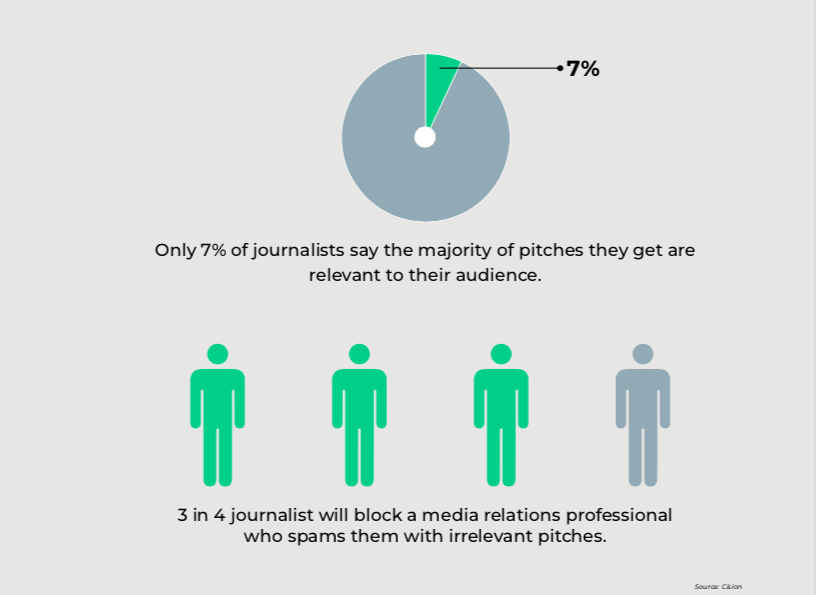
- Use embargos to reach out to top media outlets ahead of time to allow journalists to plan their editorials in advance.
- Personalize outreach for each journalist. Emails that are not personalized can sometimes be deleted simply because they look like spam.
- Distribute your press release early in the day. Research from Prowly showed that more than half of journalists prefer to receive press releases before 2 p.m.
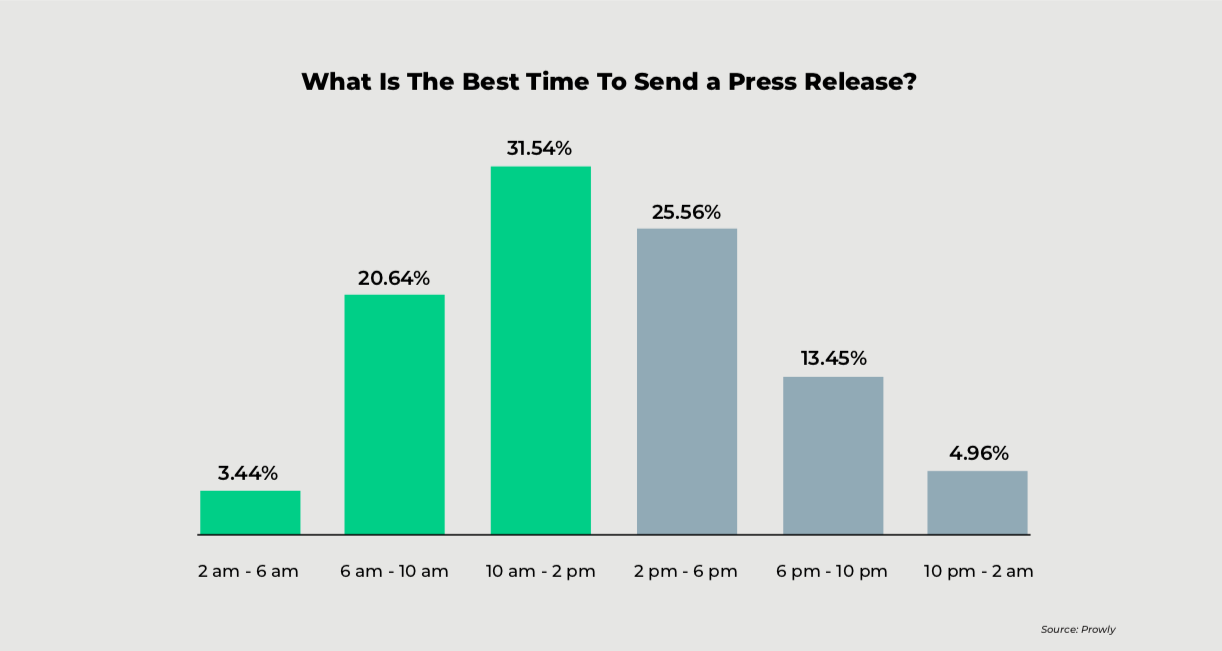
- Not every interested media outlet will publish your story immediately. You should always follow up with media sources that have not provided any coverage, to offer additional information.
Distribution Services
Another way to ensure that your audience receives a copy of your press release is to outsource distribution to an external service provider. Press release distribution services are affordable and deliver quick access and easy distribution to a wide variety of media outlets. These include:
- PR Newswire: PR Newswire is a widely recognized press release distribution service that offers comprehensive distribution to a vast network of media outlets and journalists.
- NewsWire: NewsWire is a press release distribution service that specializes in distributing news and media content to targeted, industry-specific channels and outlets.
- eRelease: eRelease is a user-friendly press release distribution service that provides affordable distribution to a wide range of media outlets, including traditional and online platforms.
- PRWeb: PRWeb is a leading online press release distribution service that focuses on maximizing online visibility and media coverage through SEO optimization and targeted distribution to online news sources and websites.
Keep in mind that using these services means you pass up the chance to build and strengthen relationships with journalists and personalize outreach to key media members.
Engage Journalists More Effectively With Well-Written Press Releases From LeadsPanda
At LeadsPanda, we help businesses write and distribute press releases more effectively. Our press release writing and distribution services help clients generate quality press releases and reach a wide network of media outlets.
Our team of industry writers can create well-crafted press releases that capture attention and convey the key messaging effectively. These press releases are tailored to meet the specific needs of businesses and are designed to be newsworthy and appealing to journalists and their audiences.
What about distribution? We ensure that press releases are sent to more than 300 top media outlets and published on various platforms to maximize reach and visibility. Clients receive a comprehensive report containing all the links where their press release has been published, including a mix of do-follow and no-follow links.
Find out how LeadsPanda can help you with your content needs.



